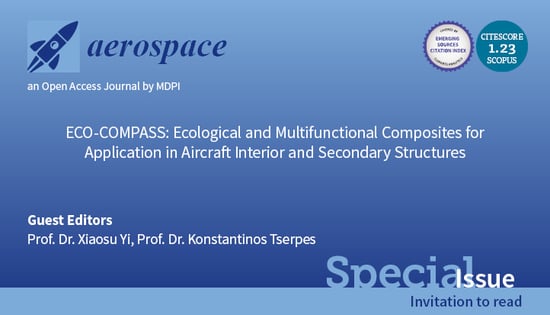Special Issue “ECO-COMPASS: Ecological and Multifunctional Composites for Application in Aircraft Interior and Secondary Structures”
Funding
Conflicts of Interest
References
- Bachmann, J.; Yi, X.; Gong, H.; Martinez, X.; Tserpes, K.; Ramon, E.; Paris, C.; Moreira, P.; Fang, Z.; Li, Y.; et al. Outlook on ecologically improved composites for aviation interior and secondary structures. CEAS Aeronaut. J. 2018, 9, 533–543. [Google Scholar] [CrossRef] [Green Version]
- Tse, B.; Yu, X.; Gong, H.; Soutis, C. Flexural Properties of Wet-Laid Hybrid Nonwoven Recycled Carbon and Flax Fibre Composites in Poly-Lactic Acid Matrix. Aerospace 2018, 5, 120. [Google Scholar] [CrossRef]
- Bachmann, J.; Wiedemann, M.; Wierach, P. Flexural Mechanical Properties of Hybrid Epoxy Composites Reinforced with Nonwoven Made of Flax Fibres and Recycled Carbon Fibres. Aerospace 2018, 5, 107. [Google Scholar] [CrossRef]
- Tserpes, K.; Kora, C. A Multi-Scale Modeling Approach for Simulating Crack Sensing in Polymer Fibrous Composites Using Electrically Conductive Carbon Nanotube Networks. Part II: Meso- and Macro-Scale Analyses. Aerospace 2018, 5, 106. [Google Scholar] [CrossRef]
- Tserpes, K.; Kora, C. A multi-scale modeling approach for simulating crack sensing in polymer fibrous composites using electrically conductive carbon nanotube networks. Part I: Micro-scale analysis. Comput. Mater. Sci. 2018, 154, 530. [Google Scholar] [CrossRef]
- Wang, C.; Ren, Z.; Li, S.; Yi, X. Effect of Ramie Fabric Chemical Treatments on the Physical Properties of Thermoset Polylactic Acid (PLA) Composites. Aerospace 2018, 5, 93. [Google Scholar] [CrossRef]
- Dong, S.; Xian, G.; Yi, X.-S. Life Cycle Assessment of Ramie Fiber Used for FRPs. Aerospace 2018, 5, 81. [Google Scholar] [CrossRef]
- Guo, M.; Yi, X. Effect of Paper or Silver Nanowires-Loaded Paper Interleaves on the Electrical Conductivity and Interlaminar Fracture Toughness of Composites. Aerospace 2018, 5, 77. [Google Scholar] [CrossRef]
- Zhang, J.; Shen, Y.; Jiang, B.; Li, Y. Sound Absorption Characterization of Natural Materials and Sandwich Structure Composites. Aerospace 2018, 5, 75. [Google Scholar] [CrossRef]
- Yi, X.-S.; Zhang, X.; Ding, F.; Tong, J. Development of Bio-Sourced Epoxies for Bio-Composites. Aerospace 2018, 5, 65. [Google Scholar] [CrossRef]
- Ramon, E.; Sguazzo, C.; Moreira, P.M.G.P. A Review of Recent Research on Bio-Based Epoxy Systems for Engineering Applications and Potentialities in the Aviation Sector. Aerospace 2018, 5, 110. [Google Scholar] [CrossRef]
© 2019 by the authors. Licensee MDPI, Basel, Switzerland. This article is an open access article distributed under the terms and conditions of the Creative Commons Attribution (CC BY) license (http://creativecommons.org/licenses/by/4.0/).
Share and Cite
Yi, X.; Tserpes, K. Special Issue “ECO-COMPASS: Ecological and Multifunctional Composites for Application in Aircraft Interior and Secondary Structures”. Aerospace 2019, 6, 17. https://doi.org/10.3390/aerospace6020017
Yi X, Tserpes K. Special Issue “ECO-COMPASS: Ecological and Multifunctional Composites for Application in Aircraft Interior and Secondary Structures”. Aerospace. 2019; 6(2):17. https://doi.org/10.3390/aerospace6020017
Chicago/Turabian StyleYi, Xiaosu, and Konstantinos Tserpes. 2019. "Special Issue “ECO-COMPASS: Ecological and Multifunctional Composites for Application in Aircraft Interior and Secondary Structures”" Aerospace 6, no. 2: 17. https://doi.org/10.3390/aerospace6020017
APA StyleYi, X., & Tserpes, K. (2019). Special Issue “ECO-COMPASS: Ecological and Multifunctional Composites for Application in Aircraft Interior and Secondary Structures”. Aerospace, 6(2), 17. https://doi.org/10.3390/aerospace6020017





